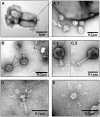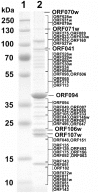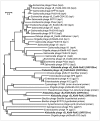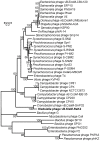Klebsiella phage vB_KleM-RaK2 - a giant singleton virus of the family Myoviridae
- PMID: 23593293
- PMCID: PMC3622015
- DOI: 10.1371/journal.pone.0060717
Klebsiella phage vB_KleM-RaK2 - a giant singleton virus of the family Myoviridae
Erratum in
- PLoS One. 2013;8(12). doi:10.1371/annotation/a1d15675-2942-41ba-92f4-3dad6bc6cac6
Abstract
At 346 kbp in size, the genome of a jumbo bacteriophage vB_KleM-RaK2 (RaK2) is the largest Klebsiella infecting myovirus genome sequenced to date. In total, 272 out of 534 RaK2 ORFs lack detectable database homologues. Based on the similarity to biologically defined proteins and/or MS/MS analysis, 117 of RaK2 ORFs were given a functional annotation, including 28 RaK2 ORFs coding for structural proteins that have no reliable homologues to annotated structural proteins in other organisms. The electron micrographs revealed elaborate spike-like structures on the tail fibers of Rak2, suggesting that this phage is an atypical myovirus. While head and tail proteins of RaK2 are mostly myoviridae-related, the bioinformatics analysis indicate that tail fibers/spikes of this phage are formed from podovirus-like peptides predominantly. Overall, these results provide evidence that bacteriophage RaK2 differs profoundly from previously studied viruses of the Myoviridae family.
Conflict of interest statement
Figures








Similar articles
-
Genome of Klebsiella sp.-infecting bacteriophage vB_KleM_RaK2.J Virol. 2012 May;86(9):5406. doi: 10.1128/JVI.00347-12. J Virol. 2012. PMID: 22492928 Free PMC article.
-
Genomic analysis of bacteriophage PBECO4 infecting Escherichia coli O157:H7.Arch Virol. 2013 Nov;158(11):2399-403. doi: 10.1007/s00705-013-1718-3. Epub 2013 May 17. Arch Virol. 2013. PMID: 23680925
-
Molecular Analysis of Arthrobacter Myovirus vB_ArtM-ArV1: We Blame It on the Tail.J Virol. 2017 Mar 29;91(8):e00023-17. doi: 10.1128/JVI.00023-17. Print 2017 Apr 15. J Virol. 2017. PMID: 28122988 Free PMC article.
-
Insights into the Alcyoneusvirus Adsorption Complex.Int J Mol Sci. 2023 May 26;24(11):9320. doi: 10.3390/ijms24119320. Int J Mol Sci. 2023. PMID: 37298271 Free PMC article.
-
Things Are Getting Hairy: Enterobacteria Bacteriophage vB_PcaM_CBB.Front Microbiol. 2017 Jan 24;8:44. doi: 10.3389/fmicb.2017.00044. eCollection 2017. Front Microbiol. 2017. PMID: 28174560 Free PMC article.
Cited by
-
Novel bacteriophages targeting wheat phyllosphere bacteria carry DNA modifications and single-strand breaks.Virus Res. 2025 Feb;352:199524. doi: 10.1016/j.virusres.2024.199524. Epub 2025 Jan 8. Virus Res. 2025. PMID: 39742975 Free PMC article.
-
Larger Than Life: Isolation and Genomic Characterization of a Jumbo Phage That Infects the Bacterial Plant Pathogen, Agrobacterium tumefaciens.Front Microbiol. 2018 Aug 14;9:1861. doi: 10.3389/fmicb.2018.01861. eCollection 2018. Front Microbiol. 2018. PMID: 30154772 Free PMC article.
-
Phages against Noncapsulated Klebsiella pneumoniae: Broader Host range, Slower Resistance.Microbiol Spectr. 2023 Aug 17;11(4):e0481222. doi: 10.1128/spectrum.04812-22. Epub 2023 Jun 20. Microbiol Spectr. 2023. PMID: 37338376 Free PMC article.
-
Characterization and genomic study of EJP2, a novel jumbo phage targeting antimicrobial resistant Escherichia coli.Front Microbiol. 2023 May 12;14:1194435. doi: 10.3389/fmicb.2023.1194435. eCollection 2023. Front Microbiol. 2023. PMID: 37250060 Free PMC article.
-
Replications of Two Closely Related Groups of Jumbo Phages Show Different Level of Dependence on Host-encoded RNA Polymerase.Front Microbiol. 2017 Jun 13;8:1010. doi: 10.3389/fmicb.2017.01010. eCollection 2017. Front Microbiol. 2017. PMID: 28659872 Free PMC article.
References
-
- Hendrix RW (2002) Bacteriophages: evolution of the majority. Theor Popul Biol 61: 471–480. - PubMed
-
- Ackerman H-W (2011) Bacteriophage taxonomy. Cambridge Publishing, Microbiology. Australia.
Publication types
MeSH terms
Substances
Associated data
- Actions
LinkOut - more resources
Full Text Sources
Other Literature Sources
Molecular Biology Databases

